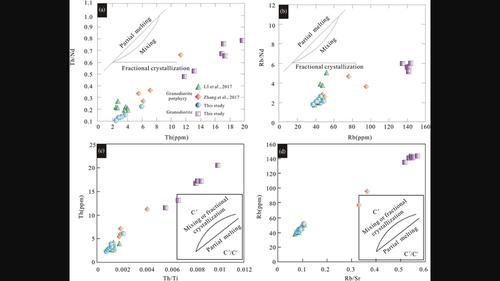Geochronology and geochemistry of granitoids of the Yanghuidongzi porphyry Cu deposit, Heilongjiang Province: Implications for petrogenesis and metallogenic setting during the Early Jurassic in the Northeast of China
IF 0.8
4区 地球科学
Q3 GEOLOGY
引用次数: 0
Abstract
The Yanghuidongzi Cu deposit is a newly discovered porphyry Cu deposit in the eastern segment of the Central Asian Orogenic Belt. The Cu mineralization is associated with granodiorite porphyry and granodiorite. This paper presents new zircon U–Pb dating, Hf–O isotopes, whole‐rock major and trace elements data for this deposit, to constrain the ore‐forming age and the magma source of the granitoids. LA–ICP–MS U–Pb dating of zircons from granodiorite porphyry and granodiorite samples yielded ages of 192.8 ± 1.7 Ma, and 198.1 ± 1.4 Ma, respectively, which are interpreted as the emplacement ages of granitoids. These age data confirm that the granodiorite porphyry is associated with the porphyry Cu deposit, and both granitic intrusion and Cu mineralization were associated with the Early Jurassic magmatism in NE China. The granodiorite porphyry has high SiO

黑龙江省杨会洞子斑岩铜矿床花岗岩的地质年代和地球化学:对中国东北早侏罗世岩石成因和成矿环境的启示
羊蹄洞子铜矿床是中亚造山带东段新发现的斑岩型铜矿床。铜矿化与花岗闪长岩斑岩和花岗闪长岩有关。本文介绍了该矿床新的锆石 U-Pb 测定、Hf-O 同位素、全岩主要元素和微量元素数据,以确定成矿年龄和花岗岩的岩浆来源。花岗闪长岩斑岩和花岗闪长岩样品中的锆石的 LA-ICP-MS U-Pb 测定年龄分别为 192.8 ± 1.7 Ma 和 198.1 ± 1.4 Ma,可解释为花岗岩的成矿年龄。这些年龄数据证实花岗闪长斑岩与斑岩型铜矿床有关,花岗岩侵入体和铜矿化均与中国东北早侏罗世岩浆活动有关。花岗闪长岩斑岩中 SiO2、Al2O3 和 Sr 含量较高,Y 和 Yb 含量较低。它富含 LILE,贫含 HFSE,被归类为赤铁矿。花岗闪长岩具有较高的 SiO2 和 K2O 含量,富含 LILE,贫含 HFSE,属于高 K 碱性 I 型花岗岩。花岗斑岩和花岗闪长岩的εHf(t)值(5.2-9.5)不等,中新生代两阶段Hf模型(TDM2)为629-905 Ma,δ18O值(4.26‰-7.50‰)不等。这些地球化学数据和锆石Hf-O同位素表明,花岗闪长斑岩起源于加厚的幼壳物质的部分熔融,而花岗闪长岩则起源于幼壳物质的部分熔融,并有额外的地幔岩浆输入。结合我们的新数据和区域构造环境,杨水洞子铜矿床和相关花岗岩形成于与古太平洋板块俯冲到欧亚大陆之下相关的压缩构造环境中。
本文章由计算机程序翻译,如有差异,请以英文原文为准。
求助全文
约1分钟内获得全文
求助全文
来源期刊

Resource Geology
地学-地质学
CiteScore
2.30
自引率
14.30%
发文量
18
审稿时长
12 months
期刊介绍:
Resource Geology is an international journal focusing on economic geology, geochemistry and environmental geology. Its purpose is to contribute to the promotion of earth sciences related to metallic and non-metallic mineral deposits mainly in Asia, Oceania and the Circum-Pacific region, although other parts of the world are also considered.
Launched in 1998 by the Society for Resource Geology, the journal is published quarterly in English, making it more accessible to the international geological community. The journal publishes high quality papers of interest to those engaged in research and exploration of mineral deposits.
 求助内容:
求助内容: 应助结果提醒方式:
应助结果提醒方式:


